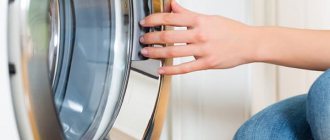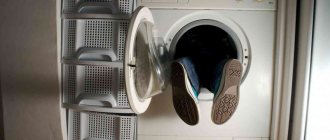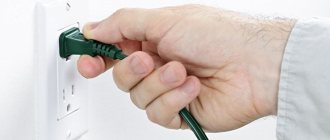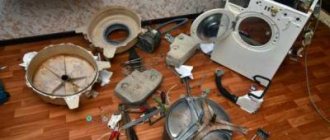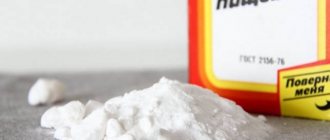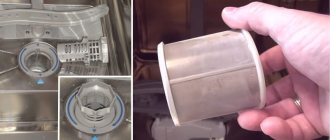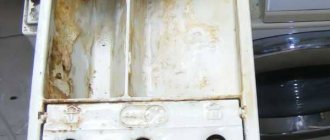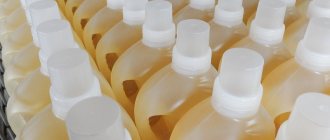04/06/2017 Technology
A breakdown of an automatic washing machine is a real disaster for modern people. How can you now cope without a faithful home assistant, do your laundry by hand, take out a loan and buy a new unit, or try to repair the old one?
All these unpleasant questions and troubles can be avoided if you know how to clean a washing machine with soda not only from scale, but also from other harmful substances.
Causes of mold and unpleasant odors
As you know, it is much easier to avoid possible problems than to eliminate their consequences later.
What reasons lead to molding of the machine and provoke a repulsive smell?
Wet drum
Often, in a hurry, having barely pulled out the washed clothes, the housewife slams the door, and the drum of the machine remains wet. And in a humid environment, fungi and other microorganisms multiply. The result is a characteristic musty odor. To ensure everything dries well, you need to wait a few hours.
But it is not recommended to leave the machine open longer, because otherwise the door will begin to sag.
Dirty hatch gasket
- After completing the washing cycle, careful users wipe the wet hatch with a rag so that it does not become overgrown with plaque.
- The same must be done with the rubber gasket. It is multi-layered because it protects the drum.
- And in each layer, various debris and small objects left in clothing pockets, as well as hair, dust and liquid, can get stuck.
- All these factors create a favorable putrefactive environment, hence the smell.
Dirty things in the drum
Sometimes worn clothes are sent to storage in the washing machine long before washing.
- If you regularly follow this habit and close the door at the same time, a strong stench will become a constant companion of your household appliance.
- It is much more convenient to use a special basket for storing dirty clothes, choosing it to match the style of the interior and the desired size.
Installation curve
If the machine is not level on the floor, it may not be completely free of water after washing. Where the slope is least, liquid will stagnate, the presence of which you will recognize by the repulsive smell of dampness and rot.
Clogged drain hose
Cleaning this spare part is a labor-intensive and practically useless process. If the hose is faulty, it is much better to replace it with a new one.
Quality and quantity of laundry detergents
Poor quality detergents do not completely dissolve in water, so they settle on the walls of the machine.
- The same thing happens with excessive use of even very expensive products.
- They are not completely washed out and also become sediment.
- And subsequently the reason for not the best aroma.
Dirty powder tray
This is the case when the reason is literally on the surface. If the tray itself is dirty, then the channel through which the detergents go deep into the machine will not be clean.
Clogged filter
This is the most common cause of odor. To keep the filter clean as long as possible, do not allow foreign objects or loose fasteners to get into the drum.
Once stuck in the filter, they accumulate smaller particles around them, preventing the liquid from passing freely.
heating element
If the heating element is covered with scale, the stench will be especially strong. After all, other dirt also sticks to the coating. It produces a particularly intense odor when washed in medium-temperature water.
Malfunctions in the sewer system
In this case, there will be an unpleasant odor not only in the drum, but also in the sink and bathtub drains.
Application
You can thoroughly clean your washing machine with baking soda, both in its pure form and in combination with other home remedies.
Soda
To rid the SMA of contamination, you need to:
- mix soda and water in a 1:1 ratio;
- apply the resulting homogeneous mass to accessible external and internal surfaces of the device;
- leave the solution for 30 minutes;
- rinse thoroughly.
After this, you should turn on the idle wash. In this way you can clean the drum, cuff, and detergent tray. Using gloves will prevent irritation on the skin of your hands.
Do you wash your shoes in the machine?
Oh yes! No
Soda + vinegar
Vinegar can complement the effective action of soda. The products do not need to be mixed; they are used separately. 500 ml of table vinegar (9%) is poured into the powder tray. A solution of soda and water (1:1) is placed in an empty drum; two teaspoons of the product are enough.
Then you need to turn on the wash at high temperature for about an hour. An additional rinse will remove any remaining dirt from the parts. After this, you can remove the drain filter and wash it, wipe the hatch, drum and cuff. The smell of vinegar will quickly evaporate from an open machine.
You can do it differently: cover the blackened surface of rubber or plastic with soda, and spray vinegar on top using a spray bottle. This will cause a chemical reaction of the substances. White foam will appear and the mold will disappear. After some time, you need to rinse the treated surface with water.
Soda + citric acid
A solution of citric acid (150 g) and soda ash (10 g) will clean the washing machine well. The mixture is added to the powder container and a single wash is started at high temperature. This procedure will remove plaque from machine parts.
Lemon acid
Soda + laundry soap
SMA can be easily cleaned with baking soda and laundry soap shavings. To do this you need:
- soak kitchen towels in a solution of baking soda, grated soap and water;
- boil things for 15 minutes over low heat;
- wash them in the machine, adding powder.
This method perfectly refreshes both towels and the washing machine itself.
Why clean your washing machine?
City water systems cannot boast of soft and clean water. It contains impurities of metals and salts. We call this kind of water hard. When heated, its impurities form a sediment that remains on the parts of the washing machine.
This process is especially intense at washing temperatures above 60 degrees. The plaque settles, and over time its layer becomes thicker.
This entails negative consequences in the operation of the device:
- Slow heating of water for washing;
- Excessive energy consumption;
- Overheating of parts and subsequent breakdowns.
Limescale is not the only enemy of a washing machine. Rubber parts become damp, mold and fungal organisms grow in them, becoming a source of repulsive odor and causing blockages and jams.
Cleaning Exterior Elements
First you need to clean the tray, rubber seals and lid, and, if necessary, other surfaces of the device. Under no circumstances should you just sprinkle white powder on all these parts. First, soda ash is mixed in equal proportions with warm water. Using a sponge or cloth, rub this mixture onto all seals, the lid, and outer surfaces.
You also need to treat the inside of the washing machine drum with soda solution. There is no need to wash it off immediately. It will take at least half an hour for the active components of soda to take effect. During this time, you can do the tray.
It is in the compartment for detergents that mold most often appears, especially if the owners abuse detergents and do not ventilate the unit. As a result, residues of powder undissolved in water gradually accumulate on the walls of the tray; they begin to turn to stone and mold.
If the tray is slightly dirty, you don’t have to take it out - just treat it with soda and leave it for half an hour. If the plaque layer is very dense, the tray must be removed and immersed for half an hour in a more liquid solution of soda ash - for 2-3 liters of warm water you will need 2-3 tablespoons of soda, respectively. There is no need to add any additional cleaning agents - there are already enough of them on the walls of the tray.
After half an hour, the remaining soda solution is removed from all surfaces with a clean damp cloth. You may need to rinse it in clean water and squeeze it out from time to time. To completely remove all traces of soda, you need to close the tray, lid and turn on the quick wash mode. All. This completes the first part of cleaning the automatic washing machine with soda ash.
How to Determine When Cleaning Is Needed
Regular monthly cleaning is the key to long and trouble-free service of the automatic machine.
If cleaning is necessary, this can be determined by characteristic signs:
- Unpleasant odor;
- Longer wash cycle;
- Excessive noise during operation;
- Unexpected outages;
- Poor quality washing.
All this indicates that your home appliance is in desperate need of care and attention.
To clean scale and mold, you can use both store-bought and homemade products. Despite their obvious cheapness and availability, folk chemistry is not always absolutely harmless to technology.
The most common are baking soda and citric acid. Let's consider their positive effects and negative factors limiting their use.
Advantages and disadvantages of using soda compositions
The main advantage of homemade soda compositions is their affordable price compared to professional cleaning solutions. Soda, vinegar, and soap are tens of times cheaper than store-bought anti-plaque products.
Cleaning a washing machine at home with baking soda is affordable for families of any income. The quality of cleaning with folk remedies is not inferior to special anti-plaque compounds.
At home, you can easily descale your washing machine with soda without harming the pipes or plastic. According to housewives, homemade solutions work no worse than store-bought products.
They do not harm the environment and do not cause allergies. Cope with odors and dirt. Doesn't take long to clean. In just a few minutes you get a clean surface without much effort or expense.
The disadvantages of traditional methods include a weak effect in case of severe pollution. If no one has worked on the automatic machine for a long time, you will have to clean it 2-3 times with soda and acetic acid. The substances will gradually reduce the layer of formations and clean the surface.
In particularly difficult situations, only professional products will help restore cleanliness. The concentrated composition will clean the heater from a layer of solid formations.
Citric acid for cleaning the washing machine
Citric acid is especially successful in combating scale on heating elements. Most store-bought chemicals include a significant percentage of this simple remedy. But it will cost many times less.
- Pour up to 100 grams of lemon into the powder tray.
- Start the wash cycle with maximum duration and temperature. Then activate the "Rinse" mode.
- If the smell has not gone away completely, you can repeat the procedure again, but under no circumstances should you increase the amount of acid!
- The procedure is carried out no more than 2 times a year!
What exactly needs to be cleaned
Most owners pour soda or citric acid into the cleaning product tray once every six months, run the unit idle - and feel completely calm, believing that they have ensured the cleanliness and safety of their machine.
Do you think so too? You are wrong. This is only one of the stages of high-quality cleaning of the washing unit. In reality, you need to take care of the following details:
- container for washing powder;
- rubber seals and cover;
- drum;
- inlet filter and waste filter;
- heating element (heating element);
- internal and external drainage hoses.
Don't be intimidated by the impressive list - you will have to work quite a bit. A universal cleaner - ordinary soda - will do the rest.
A solution of citric acid and soda
A mixture of soda and lemon works well to remove plaque.
To apply this method:
- 150 grams of citric acid are combined with 4 teaspoons of soda;
- the resulting mixture is placed in a pre-washed powder tray;
- wash at the highest possible temperature and then run a rinse cycle.
Attention! There should be no things in the machine during cleaning!
How often should you clean
Washed items leave threads, lint and dirt inside the machine. They contaminate the drum, filters, hoses, and other parts. If they are not cleaned in time, the “washing machine” will break or become completely unusable. Washing with hard water and cheap aggressive detergents also leads to contamination. In addition, the device is more likely to become dirty if you frequently wash woolen items and work clothes soiled with machine oil, fuel oil and other difficult-to-wash substances.
When you wash your usual household items, and rarely and with hot water, complete cleaning is enough to do once every 6 months. When washing work clothes and shoes that are too dirty, and if the water is hard, clean them every 3 or even 2 months. Clean the parts of the machine in stages, gradually. First of all, remove plaque from the drum and scale from the heating element. Next they work on the filters, drainage hose, cuff and tray.
The frequency of regular cleaning is affected by the frequency of use of the machine.
Experts advise cleaning the unit once every 3 months, and with frequent washing - monthly or every 1 month. The door rubber and tray must be washed and wiped after finishing any wash. To do this, use a toothbrush, a soft brush and a soft cloth. It has been noticed that hot water at a temperature of 80 degrees has an effect on dissolving scale, so sometimes it is useful to “drive” the machine, setting the maximum heat.
Regular cleaning of your washing machine will extend its life.
A common reason for cleaning is pieces of limescale that get into the drain filter and hose along with small items from pockets, hair and pet fur. In this case, cleaning is done monthly, and the drain filter is cleaned even 2 times a month. To prevent plaque, mold and odor from appearing in the machine, do not forget about its regular treatment.
For preventive purposes, in order to detect a malfunction in time and fix it, or to make sure that everything is in order with the machine, it is worth contacting a specialist every year.
Self-monitoring plays a big role in operating the washing machine. If an unpleasant odor, insufficient water heating, or malfunctions are detected, parts must be cleaned.
Baking soda for cleaning the washing machine
To get rid of mustiness and plaque, you can use regular baking soda.
- It is necessary to determine the location of molding (for example, drum, powder tray, multi-layer rubber gasket).
- Preparation of the solution: half a glass of soda + half a glass of water. The mass should be paste-like, with a fairly thick consistency.
- Protect your hands with gloves.
- Take a sponge and apply the prepared product to the moldy area.
- Use a damp cloth to remove any remaining paste from the surface.
- Select the "Rinse" program, this cycle will complete the cleaning.
Despite all the effectiveness of folk remedies, they should not be abused. If you clean too often, you can damage the components of the device, for example, the rubber gasket. Be careful and careful with equipment!
To ensure that your laundry assistant lasts as long and as well as possible, carry out such cleaning at least twice a year. Baking soda and citric acid are one of the most inexpensive and effective means for this procedure, which can maximize the life of an automatic washing machine.
Why soda
Soda is widely used by people as an economical and effective cleaning agent. White crystals can be used to safely clean almost anything: dishes, bathroom fixtures, remove fabric stains, wash clothes, and even whiten teeth. Soda has unique chemical properties.
This is an excellent adsorbent; it literally absorbs fats and dirt. And, in addition, it creates an alkaline environment in which most bacteria are not able to continue active life.
Soda neutralizes calcium salts and other harmful impurities in water, making it softer. But most importantly, it is completely non-toxic and is not a strong aggressive chemical. The exception is caustic soda, but it is practically not used in everyday life; it is needed only in the chemical industry.
To clean and disinfect your washing machine, you can use baking soda, which is used primarily in the manufacture of confectionery products. But if you need professional cleaning of the washing machine with soda, then it is better to choose soda ash.
It will better dissolve scale, mucus and grease that inevitably accumulate during operation of the washing machine. And at the same time, it is not as caustic as caustic. If you use it wisely, adhering to certain rules, everything will be fine.
Photo instructions for cleaning the washing machine
Expert recommendations
To prevent mold and unpleasant odors from appearing in the washing machine, it must be washed regularly inside and out. It is believed that household chemical products have a detrimental effect on human health. Therefore, it is worth considering using affordable and safe soda as a cleaning agent. Remember, that:
- If you wipe the car panel with a cloth that is too wet, you can damage the electronics.
- Washing items with lint must be done in a special bag.
- Do not leave wet clothes in the drum for a long time.
- A washing machine installed in the kitchen needs timely cleaning from splashes of grease and water drips.
In order to avoid incurring unplanned expenses due to an unexpectedly broken washing machine, it is necessary to regularly clean it of accumulated dirt. This will extend the life of the equipment and protect the family from the influence of pathogenic bacteria. Baking soda is an inexpensive, but effective and multifunctional product for keeping your home clean.
Assistant in the fight against scale
Limescale deposits often form on the washer's garbage filter. The part is very easy to clean using soda ash. It is easy to remove the filter element from the machine body; any housewife can cope with this task. The algorithm of actions will be as follows:
- Turn off the power to the machine, turn off the water supply tap;
- remove the lower false panel covering the filter, or open the special protective hatch (depending on the design of the washing machine);
- place a low basin under the body of the machine; it will be needed to collect the liquid that will flow when unscrewing the cap;
- cover the floor near the equipment with dry rags;
- Unscrew the plug halfway, drain the water into a container, and pull out the filter completely.
Next you can start cleaning. There are two ways to wash the garbage filter using sodium carbonate:
- add 4 tbsp. spoons of soda in 1 liter of water, stir, soak the filter element in the solution. Wait until the coating “moves away” from the part, then rinse the filter and wipe with a dry cloth;
- Clean off the scale manually: sprinkle powder on the surface of the part and wipe off the deposit with a rag. Then rinse the element in warm water and dry.
Also, with a napkin soaked in a soda solution, you need to wipe the walls of the hole where the filter is screwed into. Afterwards you can put the filter element in place. Make sure that the plug “stands up” evenly, otherwise the machine will begin to leak during the first wash.
Washing soda
In addition to baking soda, soda ash can cope with various types of contaminants. The difference is in the alkali concentration: soda ash has a higher alkali concentration, so it is used much more often when washing. That’s what it’s called: washing soda, washing soda, laundry soda. Soda ash is on sale in packs of 600 grams. Like food grade, it dissolves grease perfectly, so it is suitable for cleaning dishes, bathroom fixtures and any kitchen surfaces.
Soda ash softens water, so when washing it can protect the washing machine from scale. It whitens laundry, deodorizes, and eliminates odors. A more intense alkaline reaction allows the product to be used only for washing items made of linen, cotton and synthetics. The substance can even ruin silk and wool fabrics.
Take precautions! Unlike baking soda, this type of soda is not safe. Keep the substance away from food and use gloves when working with it. There is another type of soda - caustic soda, which is even stronger. If caustic gets on the skin, it can cause a chemical burn.
Is soda ash okay?
Sodium carbonate is a powder that is used by housewives for various purposes. Soda ash is used when washing clothes, cleaning plumbing fixtures, removing blockages, removing scale, and even washing tiles. Therefore, it is not at all necessary to buy expensive household cleaning chemicals; a cheap product that has been proven for generations will be no less effective.
To understand why soda works well in the fight against stains in automatic washing machines, you need to know what exactly “dirties” the washing machine. Some users do not realize where debris comes from in the unit, where dirt accumulates, and why scale forms. It is also unclear why equipment can smell unpleasant, it would seem that ordinary things are washed in it.
The culprit is the water in which the clothes are washed. Very rarely, users place a cleaning and softening filter in front of the machine. In most cases, hard tap water enters the system. Scale on the elements of a washing machine is formed from salts, impurities and minerals, which are present in large quantities in the liquid. This explains why limescale forms on the drum and heating element. The smell appears due to bacteria settling in the equipment.
If measures are not taken in time to remove scale, this may lead to failure of the washing machine.
Soda ash has a softening effect, which is especially important in the fight against scale. In addition, sodium carbonate has a detrimental effect on harmful microorganisms, easily dissolves dirt, and gives a whitening effect. We can say that this product is universal and ideal for caring for your washing machine. Soda protects equipment from contamination and has a disinfecting effect, thereby extending the “life” of the equipment.
Alternative ways to bleach things
You can bleach white things using soap and potassium permanganate:
2 basins of 4-5 liters of water are placed on the fire to boil. Laundry soap 72% is grated. The water has boiled, turn off the heat and add soap to one saucepan, stir until the soap dissolves properly. Approximately 10 crystals of potassium permanganate are dissolved in another saucepan. Don't overdo it: the solution should be red, not purple. Pour the solution with soap into the potassium permanganate solution. You need to mix again - the solution will foam. We put the laundry in it. Any dirty white things with stains will do: grass, oil, rust, ballpoint pens. Experience shows that stains are removed if the laundry is kept in the solution for 6-8 hours.
Ammonia and hydrogen peroxide (3%) are also used to bleach laundry:
In an enamel bucket, heat 10 liters of water to 70 degrees, add 1 tbsp. a spoonful of ammonia and 2 tbsp. l. peroxide. Using wooden tongs, place the laundry in the solution and gently stir until the items are completely wet. Leave the laundry to soak for 20-30 minutes, and then rinse and wash in the usual way.
How to clean a washing machine with soda
Baking soda is a universal cleaning agent that is used to solve various household problems. It can be used in cooking, for cleaning kitchen utensils, for removing stains during washing, or for bleaching things. Also, soda can be actively used to clean the parts of automatic washing machines from limescale. In this article we will tell you how to clean a washing machine from limescale and dirt with soda.

